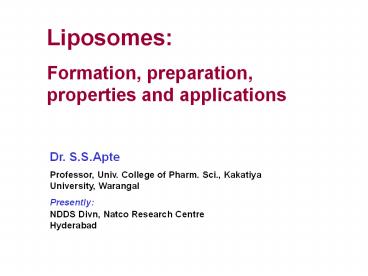Liposomes: - PowerPoint PPT Presentation
Title:
Liposomes:
Description:
Title: PowerPoint Presentation Last modified by: APTE Created Date: 1/1/1601 12:00:00 AM Document presentation format: On-screen Show Other titles – PowerPoint PPT presentation
Number of Views:358
Avg rating:3.0/5.0
Title: Liposomes:
1
Liposomes Formation, preparation, properties
and applications
Dr. S.S.Apte Professor, Univ. College of Pharm.
Sci., Kakatiya University, Warangal Presently NDD
S Divn, Natco Research Centre Hyderabad
2
Liposomal Anthracycline Antibiotics Used in Therapy Liposomal Anthracycline Antibiotics Used in Therapy Liposomal Anthracycline Antibiotics Used in Therapy Liposomal Anthracycline Antibiotics Used in Therapy Liposomal Anthracycline Antibiotics Used in Therapy
Product Drug Marketed By Registration Year
DaunoXome Daunorubicin citrate NeXstarPharmaceutical Inc. England SwedenUSA 1995 r.1995 r.1996 r.
Doxil Doxorubicin SequusPharmaceutical Inc. USA 1995
Caelix Doxorubicin Schering-Plough Selected EuropeanCountries 1995 r.
3
Definition of Liposomes
Liposomes are spherical, self closed structures
composed of curved lipid bilayers which entrap
part of the solvent, in which they freely float,
into their interior. They may consist of one or
several concentric membranes their size ranges
from 20 nm to several dozens µm, while thickness
of the membrane is around 4 nm.
4
Salient features
- Discovered in 1968 by Alec Bangham
- Delivery system for hydrophilic, lipophilic, and
amphiphilic APIs - Solubilization of lipophilic and amphiphilic
APIs - Protection of the API
- Reduction of side effects - toxicity of the
active - Sustained release
- Drug targeting
- Low application dose
5
Classification of Liposomes
- SUV Small Unilamellar Vesicles
- LUV Large Unilamellar Vesicles
- MLV Multilamellar Vesicles
- LLC Lamellar Liquid Crystalline Phase
- MVV Multivesicular vesicles
- Liposomes are composed of one to several
- hundreds concentric membranes
6
liposomes (phospholipids Cholesterol)
Vesicular delivery systems
- Vesicles
- Niosomes (Nonionic surfactants cholesterol)
7
Preparation of vesicles
- Film casting via organic solvent
- film hydration
- ether-ethanol injection
- Reverse phase evaporation
- Through mixed micellar solution
- Mechanical methods
8
Characterization of vesicles Size and size
distribution - Dynamic light scattering
Electron microscopy Coulter counter Number
of lamellae - NMR spectroscopy small
angle X ray scatter Charge -
Microelectrophoresis Entrapment efficiency - Gel
filtration Capture volume -
ultrafiltration dialysis protamine
aggregation ultracentrifugation Release
- Dialysis
9
Liposomal Delivery of Anti-Cancer Agents
- Slow Release reduced peak levels of free drug
and prolonged tumor exposure - Change in Biodistribution avoiding drug
deposition in certain tissues will reduce
tissue-specific toxicities - Tumor Targeting passive accumulation by enhanced
permeability and retention (EPR) effect
10
Phospholipids in topical pharmaceutical
applications
Drug Effects
Benzoyl peroxide Flurbiprofen Diclofenac Heparin Clindamycin phosphate Aciclovir Menthol camphor N,N-diethyl-meta-toluamide (DEET) Povidone-Iodine Tamoxifen Econazol, Miconazol Glycolic acid Bethametasone 17-benzoate improved drug delivery higher anti-bacterial efficacy better penetration improved efficacy in pain treatment improved drug delivery higher drug efficacy improved penetration higher drug efficacy sustained release, drug efficacy improvement enhanced penetration enhanced penetration, rapid onset of action controlled release, inhibition of absorption improved drug delivery efficacy improved penetration and drug retention in the skin drug retention in the skin controlled release penetration enhancement































